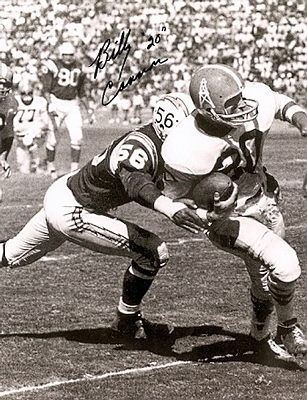

"Oregon State's Jack O’Billovich"
HELMET HUT NEWS/REFLECTIONS March 2011:
OREGON STATE’S JACK O’BILLOVICH
By Dr. Ken
It might seem quite unusual
for a resident of the New
York City metropolitan area
to have had Oregon State
University football players
as an inspiration but Jack
O’Billovich and Pete Pifer
filled the role well. As an
inveterate reader, I had a
well rounded and perhaps
extensive knowledge of some
aspects of college and
professional football due to
a penchant for collecting
the various football annuals
and the issues of Sports
Illustrated magazine that
were published during the
football season. Like many
compulsive readers, if I
began reading a book or
magazine, I would, at least
over time, read every word
including the
advertisements. Combined
with a desire to know all I
could that might allow me to
improve my own athletic
abilities, I also tried to
learn what I could from and
about any running back that
seemed to have some physical
attribute I could emulate,
relate to, or utilize for my
own purposes. Any weight
trained football player from
my era who received early
inspiration for their own
training will quickly note
that it was the November
1959 issue of Strength And
Health magazine that sparked
them to either begin weight
training, pursue it with
greater passion, or come to
the realization that “this
kind of thing could be
helpful.”
|
|
That issue also
confirmed that there
were at least a few
weight trained
football players who
were excelling as
the vast majority of
coaches still feared
that any type of
barbell related
activity would make
their charges
“muscle bound,”
slow, or less
coordinated.
Strength And Health
featured LSU great
and 1959 Heisman
Trophy winner Billy
Cannon on the cover,
and photos within of
him training under
the supervision of
former United States
Olympic
Weightlifting Team
trainer Alvin Roy in
the latter’s Baton
Rouge facility. In a
similar way, the
knowledge that Jim
Taylor, Keith
Lincoln, and Joe Don
Looney for example,
were all products of
regular strength
training activities,
and that Charley
Tolar appeared as if
he should have been,
provided tremendous
inspiration for my
own physical
preparation.
 |
Two other names I noted were Oregon State’s Pete Pifer and Jack O’Billovich. Pifer was a hard charging fullback as was O’Billovich. Pifer as a sophomore wasn’t even noted in the ’64 pre-season publications and did not hit the national consciousness until 1965, having played as the second stringer behind Booker Washington in the previous Rose Bowl contest. O’Billovich caught my attention because he was mentioned in the 1964 Street And Smith College Football Yearbook as a backup with the accompanying description of “…with another veteran, Jack O’Billovich, 190, in reserve,” but was a 225 pound All American linebacker by the conclusion of the 1964 season. Playing for an excellent Oregon State team that faced off against Michigan in the Rose Bowl, there was some national exposure but like most Northwest region teams, it was limited. In the very small and almost cult like world that was weightlifting and weight training in the early to mid-1960’s, any athlete that was an admitted product of strength training was a known commodity and “the word” was that “Mad Dog” as Jack was popularly referred to, threw a lot of weights around all year long. Working hard enough to travel the gauntlet from a 5’11” 190 pound reserve fullback to a 225 pound All American linebacker indicated a lot of hard work and the photos clearly showed what was a strong, muscular appearance, even in his uniform. There was no doubt that Mad Dog fulfilled the qualifications of “my kind of player” and one I could learn from.